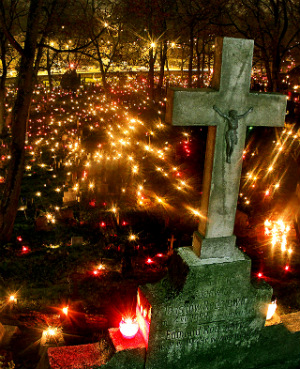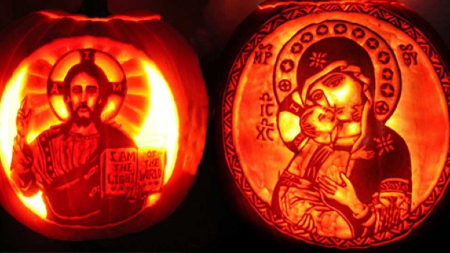Feuillants
FREE Catholic Classes
The Cistercians who, about 1145, founded an abbey in a shady valley in the Diocese of Rieux (now Toulouse ) named it Fuliens, later Les Feuillans or Notre-Dame des Feuillans ( Latin folium, leaf), and the religious were soon called Feuillants ( Latin Fulienses ). Relaxations crept into the Order of Cîteaux as into most religious congregations, and in the sixteenth century the Feuillant monastery was dishonoured by unworthy monks. A reform was soon to be introduced, however, by Jean de la Barrière, b. at Saint-Céré, in the Diocese of Cahors, 29 April, 1544; d. 25 April, 1600. Having completed a successful course in the humanities at Toulouse and Bordeaux, at the age of eighteen he was made commendatory Abbot of the Feuillants by the King of France, succeeding Charles de Crussol, who had just joined the Reformers. After his nomination he went to Paris to continue his studies, and then began his lifelong friendship with the celebrated Arnaud d'Ossat, later cardinal. In 1573 Barrière, having resolved to introduce a reform into his abbey, took the habit of novice, and after obtaining the necessary dispensations, made his solemn profession and was ordained priest, some time after 8 May, 1573. His enterprise was a difficult one. There were twelve monks at Les Feuillans who refused to accept the reform, and unmoved by the example and exhortations of their abbot, resolved to do away with him, by means of poison. Their attempts, however, were frustrated. In 1577, having received the abbatial benediction, he solemnly announced his intention of reforming his monastery, and made the members of the community understand that they had either to accept the reform or leave the abbey ; they chose the latter and dispersed to various Cistercian houses. Their departure reduced the community to five persons, two professed clerics, two novices, and the superior. The rule was interpreted in its most rigid sense and in many ways even surpassed. Sartorius in his work "Cistercium bis-tertium" sums up the austerities of the reform in these four points: (1) The Feuillants renounced the use of wine, fish, eggs, butter, salt, and all seasoning. Their nourishment consisted of barley bread, herbs cooked in water, and oatmeal. (2) Tables were abolished; they ate on the floor kneeling. (3) They kept the Cistercian habit, but remained bare-headed and barefoot in the monastery. (4) They slept on the ground or on bare planks, with a stone for pillow. They slept but four hours. Silence and manual labour were held in honour. The community was increased rapidly by the admission of fervent postulants.
In 1581 Barrière received from Gregory XIII a Brief of commendation and in 1589 one of confirmation, establishing the Feuillants as a separate congregation. In spite of the opposition of the abbots and general chapters of Cîteaux, the reform waxed strong. In 1587 Sixtus V called the Feuillants to Rome, where he gave them the church of S. Pudentiana, and the same year, Henry III, King of France, constructed for them the monastery of St. Bernard, in the Rue Saint-Honoré, Paris. In 1590, however, the Peasants' War brought about dissensions. While Barrière remained loyal to Henry III, the majority of his religious declared for the League. As a result, in 1592 Barrière was condemned as a traitor to the Catholic cause, deposed, and reduced to lay communion. It was not until 1600 that, through the efforts of Cardinal Bellarmine, he was exonerated and reinstated. Early in the same year, however, he died in the arms of his friend Cardinal d'Ossat . In 1595 Clement VIII exempted the reform from all jurisdiction on the part of Cistercian abbots, and allowed the Feuillants to draw up new constitutions, containing some mitigations of the primitive rigour. These were approved the same year. In 1598 the Feuillants took possession of a second monastery in Rome, San Bernardo alle Terme. In 1630 Pope Urban VIII divided the congregation into two entirely distinct branches: that of France, under the title of Notre-Dame des Feuillants; and that of Italy, under the name of Bernardoni or Reformed Bernardines. In 1634 the Feuillants of France, and in 1667 the Bernardines of Italy modified somewhat the constitutions of 1595. In 1791 at the time of the suppression of the religious orders, the Feuillants possessed twenty-four abbeys in France ; almost all the religious were confessors, exiles, or martyrs. The Bernardines of Italy eventually combined with the Order of Cîteaux. The congregation of the Feuillatns has given a number of illustrious personages to the Church, among others: Cardinal Bona, the celebrated liturgist and ascetical writer (d. 1674); Gabriele de Castello (d. 1687), general of the Italian branch, who also received the cardinal's hat; Dom Charles de Saint-Paul, first general of the Feuillants of France, afterwards Bishop of Avranche, who published in 1641 the "Geographia Sacra"; among theologians, Pierre Comagère (d. 1662), Laurent Apisius (d. 1681), and Jean Goulu (d. 1629). Special mention should be made of Carlo Giuseppe Morozzi (Morotius), author of the most important history of the order, the "Cistercii reflores centis … chronologica historia". Many martyrologies give Jean de la Berrière (25 April) the title of Venerable. The Abbey des Feuillants was authorized by papal Brief to publicly venerate his remains, but the cause of beatification has never been introduced.
The F EUILLANTINES, founded in 1588 by Jean de la Barrière, embraced the same rule and adopted the same austerities as the Feuillants. Matrons of the highest distinction sought admission into this severe order, which soon grew in numbers, but during the Revolution, in 1791, the Feuillantines disappeared.
Join the Movement
When you sign up below, you don't just join an email list - you're joining an entire movement for Free world class Catholic education.
-

-
Mysteries of the Rosary
-
St. Faustina Kowalska
-
Litany of the Blessed Virgin Mary
-
Saint of the Day for Wednesday, Oct 4th, 2023
-
Popular Saints
-
St. Francis of Assisi
-
Bible
-
Female / Women Saints
-
7 Morning Prayers you need to get your day started with God
-
Litany of the Blessed Virgin Mary
All Saints' Day, Halloween and All Souls' Day: What's the difference?
-

Should Christians Celebrate Halloween?
-

Since when did Halloween become a Christian holiday?
-
ADORABLE: A Little Boy's Heartfelt Lunchtime Prayer
-
Scientists Decode 3,000-Year-Old Babylonian Tablet, Revealing Potential Location of Noah's Ark
Daily Catholic
 Daily Readings for Friday, November 01, 2024
Daily Readings for Friday, November 01, 2024 St. Valentine Berrio-Ochoa: Saint of the Day for Friday, November 01, 2024
St. Valentine Berrio-Ochoa: Saint of the Day for Friday, November 01, 2024 Litany of the Saints: Prayer of the Day for Friday, November 01, 2024
Litany of the Saints: Prayer of the Day for Friday, November 01, 2024- Daily Readings for Thursday, October 31, 2024
- St. Wolfgang: Saint of the Day for Thursday, October 31, 2024
- Memorare: Prayer of the Day for Thursday, October 31, 2024
![]()
Copyright 2024 Catholic Online. All materials contained on this site, whether written, audible or visual are the exclusive property of Catholic Online and are protected under U.S. and International copyright laws, © Copyright 2024 Catholic Online. Any unauthorized use, without prior written consent of Catholic Online is strictly forbidden and prohibited.
Catholic Online is a Project of Your Catholic Voice Foundation, a Not-for-Profit Corporation. Your Catholic Voice Foundation has been granted a recognition of tax exemption under Section 501(c)(3) of the Internal Revenue Code. Federal Tax Identification Number: 81-0596847. Your gift is tax-deductible as allowed by law.







 Daily Readings for Friday, November 01, 2024
Daily Readings for Friday, November 01, 2024 St. Valentine Berrio-Ochoa: Saint of the Day for Friday, November 01, 2024
St. Valentine Berrio-Ochoa: Saint of the Day for Friday, November 01, 2024 Litany of the Saints: Prayer of the Day for Friday, November 01, 2024
Litany of the Saints: Prayer of the Day for Friday, November 01, 2024


